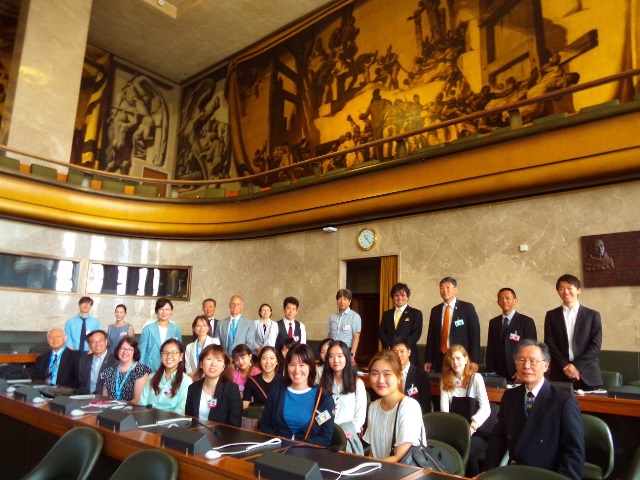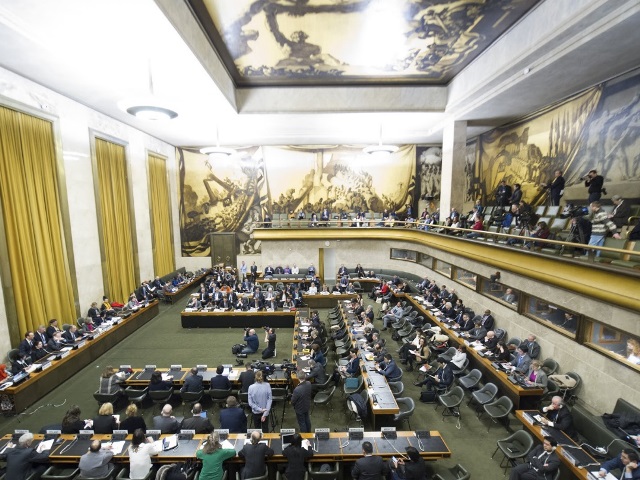

1.国際連合による議論
国際連合は、1945年の創立以来、国連憲章第11条(国連総会が、軍縮について審議し、加盟国もしくは安全保障理事会に勧告を行うことを規定)等に基づき、軍縮問題についても積極的に取り組んできた。
冷戦時代は、非同盟運動諸国(NAM)のイニシアチブによって、1978年、1982年、1988年と計3 回の国連軍縮特別総会が開催されるなどの動きはあったものの、全体としては国連を通じた具体的な軍縮・不拡散上の成果は限定的であり、むしろ二国間又は地域的な枠組みを通じて主要な軍縮の合意が形成されてきた。
他方、国連は基本的に総会における議論及び決議の採択という形で軍縮・不拡散に関与してきている。これらの議論や決議は、その時々の国際情勢、安全保障環境の中で国際社会の軍縮・不拡散問題についての関心や考えを反映したものであり、中長期的にみれば、これらの問題についての国際世論の形成に大きな役割を果たしてきた。
冷戦終焉後は、国連軍備登録制度の設置(1991年)、包括的核実験禁止条約(CTBT)の国連総会における採択(1996年)、国連小型武器行動計画の採択(2001年)等、国連総会の場を通じて軍縮・不拡散の具体的な成果が上げられている。また、安全保障理事会も1992年1月に軍縮・不拡散の重要性を強調する議長声明を発出したほか、2001年の米同時多発テロ以降のテロ組織等非国家主体に対する大量破壊兵器拡散への懸念の高まりを受けて、2004年4月には不拡散に関する安保理決議第1540号を採択し、さらに、2009年9月に行われた核不拡散・核軍縮に関する安保理首脳会合において安保理決議第1887号を採択した。また、2006年以降、安保理は北朝鮮及びイランといった個別の核問題について、制裁措置を含む決議を採択しており、国際的な不拡散体制の強化に安保理が果たす役割は、近年急速に増大している。
2.国連総会第一委員会と国連軍縮委員会
国連において軍縮・不拡散分野の問題は、通常すべての加盟国が参加できる以下の二つの総会補助機関で行われている。すなわち、総会の会期中に開催され、軍縮・国際安全保障関係のすべてのテーマを議論する「国連総会第一委員会」と、総会の枠外で特定の問題に対する国際的・地域的な取組をその都度重点的に取り上げて議論する「国連軍縮委員会(UNDC)」の二つである。
(1) 国連総会第一委員会
従来、国連総会の第一委員会においては、軍縮問題が、政治、安全保障、技術の問題等と一緒に議論されていたが、1978年の第1回国連軍縮特別総会は、「総会の第一委員会は、軍縮問題及び関連する国際安全保障問題のみを取り扱う」旨の決定を行い、以降第一委員会では主として軍縮・国際安全保障問題が議論されてきている。この委員会は、毎年秋の国連総会一般討論後、約5週間の会期で開催される。
第一委員会では毎年数多くの軍縮関連の決議が採択され、その動向は軍縮・不拡散の流れを見極める上で極めて重要である。日本も毎年、この分野における重要事項の決議案を提出している。
具体的には、核軍縮について、1994年から1999年まで「究極的核廃絶決議案」を提出し、2000年から2004年まで、2000年の核兵器不拡散条約(NPT)運用検討会議の成果を踏まえて、全面的核廃絶に至るまでの具体的道筋を示した決議案「核兵器の全面的廃絶への道程」を提出し、2005年には、それまでの決議案を新たに構成し直し、重複を避け、簡潔で力強い決議案とした「核兵器の全面的廃絶に向けた新たな決意」を提出し、国際社会より変わらぬ圧倒的支持(2009年は171か国の過去最多の賛成により採択)を得ている。
また、日本は同委員会において、小型武器問題について国際社会で本格的に提起された1995年からほぼ毎年、小型武器に関する決議案を提出している。2007年の決議案は、2008年に開催される国連小型武器隔年会合の日程と議題を定め、小型武器への国際的取組の道筋を明確にするとともに、2005年に定められたトレーシング国際文書や、2006年に政府専門家会合が報告書を提出した非合法ブローカリングへの取り組みを含め、行動計画への各国の取り組みをまとめた国別報告書の提出を各国に求めるものである。同決議案は日本とコロンビア、南アフリカにより共同提案され、圧倒的多数の賛成により採択された。
(2) 国連軍縮委員会(UNDC)
国連は、軍縮問題について研究・勧告を行う目的で、当初「原子力委員会」と「通常軍備委員会」の2つの委員会を設置した。その後、1952年の第6回国連総会において、両者の業務を統合し、新たな軍縮交渉を行う機関として「国連軍縮委員会(UNDC)」が設置された。この委員会は、軍縮問題で見るべき成果を上げることができず、長い間休眠状態にあったが、1978年の第1回国連軍縮特別総会において、この委員会を改編し、すべての国連加盟国が参加する国連総会の補助機関として、現在の国連軍縮委員会を設立することが決定された。
国連軍縮委員会は、その翌年の1979年より毎年、4~5月の時期に約3~4週間の会期でニューヨークにて議論を行っており、慣行として、同一の議題を3 年間継続して扱う。1997年から1999年まで3年間継続して論じられた議題は、「非核兵器地帯」、「第4回軍縮特別総会」及び「実際的軍縮」の3つであった。
2000年からは、「核軍縮プロセスを進めるための方法と措置」及び「通常兵器の分野における実効的な信頼醸成措置」の2つの議題が取り上げられた。3年目に当たる2002年は例外的に開催されず、2003年に継続審議がなされたが、核軍縮及び通常兵器の両分野共に参加国間での合意が達成されず、作業文書は採択されなかった。
2004年から新たな議題で議論が行われる予定であったが、2004年、2005年とも議題について合意が得られないまま会期が終了した。
2006年には、新たに「核軍縮及び核兵器不拡散の目的を達成するための勧告」、「通常兵器分野における実効的な信頼醸成措置」、「UNDCの作業方法の改善措置」の議題が合意され、同議題の下2008年まで3年にわたり議論がなされたが、コンセンサス文書を採択することはできなかった。
2009年からは「第4次軍縮の10年宣言」及び「核軍縮及び核兵器不拡散の目的を達成するための勧告」について議論が行われている。
3.安全保障理事会
安全保障理事会は、2004年4月に、不拡散に関する安保理決議第1540号を全会一致で採択した。同決議は、非国家主体への大量破壊兵器等の拡散を防止することを目的としており、すべての国連加盟国に、(1)大量破壊兵器等の拡散を禁ずるための法的措置をとること、(2)厳格な輸出管理制度を策定・維持すること等を求めるものである。この決議に基づき、安保理の下に設置期間を2年間とする「1540委員会」が置かれ、すべての加盟国が、本件決議の実施につき報告することが求められた(その後、同委員会のマンデートは、2回の安保理決議(最近では2008年4月の決議第1810号。)を経て、2011年4月まで延長された。)。
2009年9月、核不拡散・核軍縮に関する安保理首脳会合が開催され、「核兵器のない世界」に向けた決意を表明しつつ、核軍縮、不拡散、原子力の平和的利用、核セキュリティ等を包括的にカバーする安保理決議第1887号が全会一致で採択された。
安保理は、個別の地域問題についても、決議を発出してきており、特に、2006年以降は、北朝鮮及びイランの核問題等に関して一連の決議が採択されている。
2006年7月、安保理は、同月の北朝鮮によるミサイル発射に対して、安保理決議第1695号を全会一致で採択した。同決議は北朝鮮に対し、弾道ミサイル計画活動の停止等を要求するとともに、すべての国連加盟国に厳格な輸出管理等を要求している。同年10月の北朝鮮の核実験実施発表に対しては、我が国を議長国とする安保理は、同月、決議第1718号を全会一致で採択した。同決議は、北朝鮮に対し、すべての核兵器及び既存の核計画の放棄等を要求するとともに、すべての加盟国が、核・ミサイル関連の特定品目等の供給防止、奢侈品の輸出禁止等を行うことを要請している。また、北朝鮮は、2009年5月25日に核実験を強行した。これを受けて、安保理は、6月13日、北朝鮮が実施した核実験を強く非難し、追加的な制裁措置を課す内容の決議第1874号を全会一致で採択した。同決議は、北朝鮮に対する武器禁輸の範囲を拡大したほか、兵器等禁輸品目の積載が懸念される北朝鮮出入船舶の貨物検査等を各国に要請している。
国際社会の度重なる要求を無視してウラン濃縮関連活動等を行ってきたイランに対して、安保理は、2006年7月、すべての濃縮関連・再処理活動の停止を義務付ける安保理決議第1696号を採択した。また、同年12月には、濃縮関連・再処理活動及び重水関連の拡散上機微な核活動に関連する物資、人、資金に関する措置を含む国連安保理決議第1737号が、さらに2007年3月には、資産凍結対象等の追加や武器等の取引に措置対象を拡大する措置を含む国連安保理決議第1747号が、それぞれ全会一致で採択された。さらに、2008年3月には、イランが累次の安保理決議を遵守していないことを受け、資産凍結対象等のさらなる追加やイランへの供給禁止品目、技術の拡大等の措置を追加する決議第1803号が採択された。
4.国連軍縮諮問委員会
国連軍縮諮問委員会は、国連事務総長の諮問機関であり、軍縮問題一般につき事務総長に直接助言を行う。例えば、1998年、国連は機構改革の一環として、政務局内の軍縮センターを軍縮局という独立の局に格上げしたが、これはこの委員会の勧告に基づいた措置であった。また、ジュネーブの国連軍縮研究所(UNIDIR)の運営を監督する理事会としての機能も併せ持つ。
この委員会の沿革は、1978年の第1回国連軍縮特別総会でワルトハイム国連事務総長(当時)が行った提案に基づき、事務総長の下に30人の有識者より構成される軍縮諮問委員会が設置されたことに始まる。当時の委員会は、計7回の会合を開催して1981年にその任務を終了したが、1982年、第37回国連総会決議(37/99K)によって同委員会の復活が決定され、現在に至っている(1989年に現在の名称に改定)。
この委員会は、毎年2回、ニューヨークとジュネーブで会合を開催している。メンバーについては、個人の識見を基礎とし、公平な地域代表の原則を考慮して事務総長が任命する委員から構成されることとなっており、委員数は約20名である。委員は個人の資格で任命される。日本からは、1999年から2002年まで田中義具外務省参与(元軍縮代表部大使)が、2003年から2006年は猪口邦子前軍縮代表部大使が委員を務めた。
2008年1月からは阿部信泰駐スイス大使が委員に任命されている。
2009年2月に開催された第51回国連軍縮諮問委員会では「サイバー戦争と国家安全保障に対する影響」及び「国連の役割を含む検証分野の強化方法」について,同年7月の第52回国連軍縮諮問委員会では,これら議題に加え,2010年NPT運用検討会議に向けた概念的問題についても討議された。
5.国連軍縮会議
(1)国連軍縮会議とは
国連軍縮会議は,1988年の第3回国連軍縮特別総会において,竹下内閣総理大臣(当時)が国連主催の軍縮会議を日本で開催する用意がある旨表明したことを受けて,翌1989年(平成元年)以来,日本政府の協力の下,国内の地方都市でほぼ毎年開催されてきている。
国連軍縮会議を日本で開催することは,日本の軍縮に対する積極的な姿勢を国内外に示し,軍縮に関する国際的な議論を活性化する点で大きな意義を有しており,これまで,被爆地広島・長崎をはじめ,京都,仙台,札幌,秋田,金沢,大阪,横浜,さいたま,新潟,松本,静岡で開催されてきた。
なお,国連軍縮会議は,国連総会やジュネーブ軍縮会議などのように条約交渉や決議採択を行うものではなく,各国政府代表や軍縮の有識者等がテーマに沿った討議を行うものである。
(2)直近3回の開催実績
第26回国連軍縮会議(長崎)(2016年12月) (注)「核兵器のない世界へ 長崎国際会議」として開催
(注)第23回までの開催都市及び開催年は以下のとおり。
京都(1989年,1991年,1993年,1999年,2002年,2005年),仙台(1990年),広島(1992年,1994年,1996年),長崎(1995年,1998年),札幌(1997年,2004年,2007年),秋田(2000年),金沢(2001年),大阪(2003年),横浜(2006年),さいたま(2008年,2010年),新潟(2009年),松本(2011年)
6.国連ミサイル専門家パネル
イランが提出したミサイルに関する国連総会決議に基づいて、ミサイル問題をあらゆる角度から検討するために設置された政府専門家パネルであり、これまで3回にわたりパネルが開催され(第1回:2001-02年、第2回:2004年、第3回:2007-08年)、それぞれ23か国から政府専門家が参加した。第1回及び第3回パネルの結果、国連総会(2002年及び2008年)にそれぞれ国連事務総長報告が提出された。ミサイルについて国連の場でこのような専門家会合が開催されたこと自体は有益であったが、参加国の立場・思惑の相違により、取り組むべき方向性を提示するには乏しい内容となった。第2回パネルでは、参加国の見解の相違により、報告書に合意できないまま会合が終了した。
軍縮部は、核軍縮と核拡散防止の実現を進めるとともに、化学・生物兵器を含め、その他の大量破壊兵器に関する軍縮レジームの強化を図る。また、通常兵器の軍縮、とくに現代の紛争でしばしば使用される小型武器の不正取引の停止に努める。それには、以下が含まれる。
- 武器の回収と貯蔵管理計画
- 「通常兵器登録制度」や軍事支出に関する標準化された報告制度など、軍備問題の透明性
- 元戦闘員の武装解除や復員、市民社会への再統合
- 対人地雷の使用制限とそれに続く軍縮
軍縮部は、総会とその第1委員会、軍縮委員会、ジュネーブ軍縮会議、その他の機関の作業を通して、軍縮分野の規範設定活動に実質的かつ行政的支援を提供する。また、非核地帯、地域や小地域の透明性レジームなど、地域の軍縮活動も奨励している。さらに、国連の軍縮活動に関する教育計画も支援する。